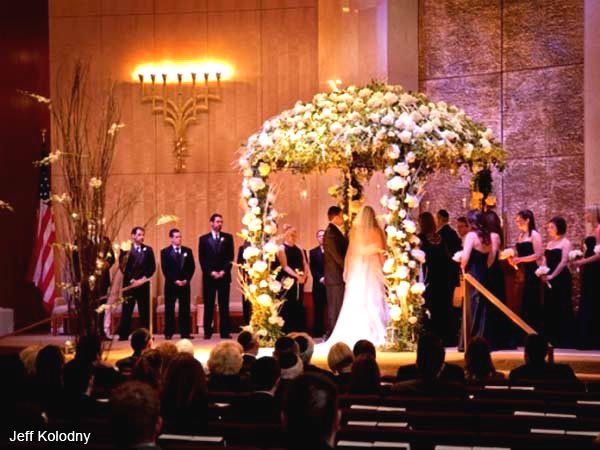#33 Weddings
#33 Weddings
 While wedding ceremonies vary, common features of a Jewish wedding include a ketubah (marriage contract) which is signed by two witnesses, a wedding canopy (chuppah or huppah), a ring owned by the groom that is given to the bride under the canopy, and the breaking of a glass. Jewish weddings occur between two people in love for both straight and gay/lesbian couples. In Hebrew, the groom is called the hatan and the bride is the kalah.
While wedding ceremonies vary, common features of a Jewish wedding include a ketubah (marriage contract) which is signed by two witnesses, a wedding canopy (chuppah or huppah), a ring owned by the groom that is given to the bride under the canopy, and the breaking of a glass. Jewish weddings occur between two people in love for both straight and gay/lesbian couples. In Hebrew, the groom is called the hatan and the bride is the kalah.
#1 WATCH:
#2 STUDY: The Ketubah
 Before the wedding ceremony, the groom (chatan) agrees to be bound by the terms of the ketubah, or marriage contract, in the presence of two witnesses, whereupon the witnesses sign the ketubah.[4] The ketubah details the obligations of the groom to the bride, among which are food, clothing, and marital relations. This document has the standing of a legally binding agreement. It is often written as an illuminated manuscript that is framed and displayed in their home.[5] Under the chuppah, it is traditional to read the signed ketubah aloud, usually in the Aramaic original, but sometimes in translation. Traditionally, this is done to separate the two basic parts of the wedding.[6] Secular couples may opt for a shortened version to be read out.
Before the wedding ceremony, the groom (chatan) agrees to be bound by the terms of the ketubah, or marriage contract, in the presence of two witnesses, whereupon the witnesses sign the ketubah.[4] The ketubah details the obligations of the groom to the bride, among which are food, clothing, and marital relations. This document has the standing of a legally binding agreement. It is often written as an illuminated manuscript that is framed and displayed in their home.[5] Under the chuppah, it is traditional to read the signed ketubah aloud, usually in the Aramaic original, but sometimes in translation. Traditionally, this is done to separate the two basic parts of the wedding.[6] Secular couples may opt for a shortened version to be read out.
#3 WATCH: The Ketubah
#4 STUDY: The Chuppah
 A chuppah (Hebrew: חוּפָּה) is a canopy under which a Jewish couple stand during their Jewish wedding ceremony. It consists of a cloth or sheet, sometimes a tallit, stretched or supported over four poles, or sometimes manually held up by attendants to the ceremony. A chuppah symbolizes the home that the couple will build together.
A chuppah (Hebrew: חוּפָּה) is a canopy under which a Jewish couple stand during their Jewish wedding ceremony. It consists of a cloth or sheet, sometimes a tallit, stretched or supported over four poles, or sometimes manually held up by attendants to the ceremony. A chuppah symbolizes the home that the couple will build together.
A traditional chuppah, especially within Orthodox Judaism, recommends that there be open sky exactly above the chuppah,[3] although this is not mandatory among sephardic communities. If the wedding ceremony is held indoors in a hall, sometimes a special opening is built to be opened during the ceremony. Many Hasidim prefer to conduct the entire ceremony outdoors. It is said that the couple’s ancestors are present at the chuppah ceremony.[4]
In Yemen, the Jewish practice was not for the groom and his bride to be secluded in a canopy (chuppah) hung on four poles, as is widely practised today in Jewish weddings, but rather in a bridal chamber that was, in effect, a highly decorated room in the house of the groom. This room was traditionally decorated with large hanging sheets of colored, patterned cloth, replete with wall cushions and short-length mattresses for reclining.[5]
#5 WATCH: The Chuppah
#6: The #7: Seven Wedding Blessings and the Seven Circles
A bride traditionally walks around her beloved seven times when she arrives at the Chuppah. It’s also customary to recited seven short blessings called the “sheva brachot.” The #7 recalls the Jewish story of creation which took seven days in biblical tradition. The relationship of seven circle and seven wedding blessings is the idea a new married couple is like the creation of a new world.
#8 Watch – The Horah!
# 7 Review and Response
1. What is the name of the Jewish marriage contract?
2. How many times does a bride traditionally circle her beloved? Why?
3. What is the name of the Jewish wedding canopy?
4. What is the last part of the wedding ceremony?
5. If you get married, what unique custom would you like to include in your ceremony?
Need some help? We’re here for you. At any time, if you have any questions, please contact one of our teachers so we can help you. Also, at the end of the session, remember to review your responses in your Tamid Workbook so you can get credit for this lesson. Behatzlacha (Hebrew for good luck)! You can reach Sarah at (646)360-0689 or connect@tamidnyc.org
